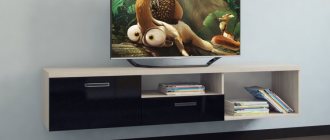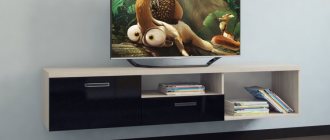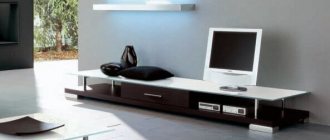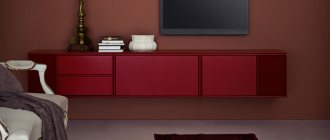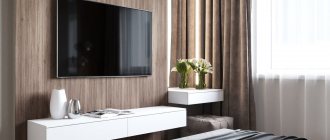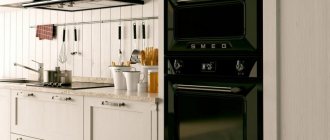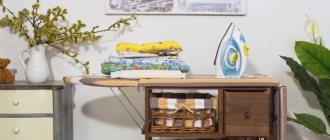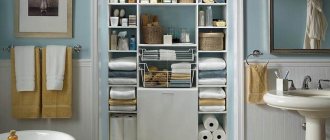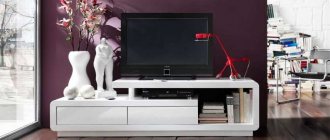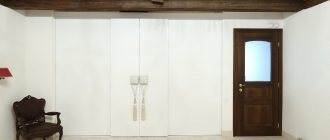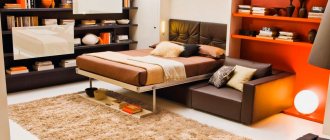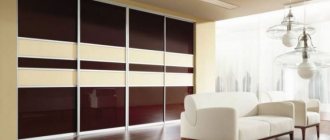<
>
The small dimensions of the living room often lead to the need to install the TV on a cabinet. Although, if you choose the right model, then in a large room this approach will allow you to get rid of the clutter of furniture. One of the most original solutions will be a glass TV stand.
Glass TV stand in the interior - advantages and features
When choosing glass models, a considerable list of their advantages immediately emerges:
- Will create the effect of lightness. Even serious structures with large dimensions visually lose weight, thanks to the ability of glass to diffuse light;
- Compatibility with other materials. Glass goes well with the vast majority of modern materials. It will look equally beautiful in combination with wood, plastic or chromed steel;
- Will fit into any interior. It is unlikely that you will find a style in which glass will look out of place;
- Rich possibilities in terms of design and decor. There is no limit to the imagination of designers;
- Relatively low price tag. You don’t have to go broke paying exorbitant sums;
- Complete environmental safety. Glass does not emit any toxic substances. Does not react with the environment. Completely neutral material;
- Heat resistance. The material does not burn or melt. Although contact with open fire will still spoil the appearance of the product.
Unfortunately, there are also disadvantages. It is better to avoid such cabinets if there are small children in the house. Even without taking into account the fact that they will significantly spoil the appearance with handprints, children can easily be injured by fragments. It is difficult to explain to them that hitting glass with heavy objects is not a good idea. In any case, you will be tortured to erase all the “traces” of their pranks from the cabinet. In addition, many types of glass are susceptible to mechanical damage. You can no longer disguise the scratches that appear.
What kind of glass is used in the manufacture of glass TV stands?
Most often, the following varieties of this material are used to make glass TV stands:
- Tempered. Standard thickness can vary from 8 to 20 mm. The formation is first heated at a temperature of 600°C and then very sharply cooled. After tempering glass, its strength increases significantly. Such a sheet can support the weight of an adult. But, when hit from the end, the layer crumbles into many blunt pieces. It’s impossible to get hurt by them, but there will be a lot of debris. But it cannot be scratched. Cannot be drilled;
- Textural. People call it “crushed ice.” Fine glass chips are placed inside the tempered sheet;
- Float. The most common option. Smooth, even, actively used in the manufacture of furniture. It has an affordable price tag;
- Triplex. Several glass layers are combined into one using shockproof films or a special liquid. This type of glass is often called laminated glass. Very durable, but quite weighty. If you manage to break it, it will be large pieces covered with a network of cracks;
- Stemalit (enameled). On one side, the glass sheet is painted with special enamel. After which it is melted. The paint becomes part of the sheet and cannot be removed. It cannot be cut or drilled by hand, as it is a type of tempered glass;
- Lakobel. Painted float glass. It is not subject to hardening;
- Fiberglass. Very light, unbreakable material. Does not scratch. High level of strength;
- Acrylic (plexiglass). A very plastic material, amenable to all types of processing (cutting, drilling, gluing). It is painted in mass in all possible colors. Almost 3 times lighter than ordinary glass and 5 times stronger. It is very difficult to break it. Its only drawback is its instability to scratches;
- Optiwhite. Clarified glass with maximum light transmittance;
- With optical effect. From different viewing angles it may appear transparent, tinted or mirrored. Multilayer. Between the layers there is a thin layer with a liquid crystal base.
Particular attention should be paid to the absence of defective defects. These are considered:
- "Midge". If you run your hand over the glass, you will feel multiple sharp crystalline inclusions. They can be in the thickness of the glass;
- Single or overlapping closed bubbles. For furniture, this is a reason for discarding;
- Open blisters;
- Funnel-shaped or straight chips with stratification. Always check the edge. This defect is the result of poor quality cutting;
- Sharp teeth;
- Multiple scratches deeper than 0.02 mm and visible from the outside.
Helpful hints
The following short recommendations will help you choose and place the “mirror plus TV” design correctly.
- To prevent the mirror from “glaring”, it is important to place it correctly. You should not mount the composition opposite a window or in places where the sun's rays most often fall. Artificial lighting creates much less problems when watching TV than natural lighting.
- With properly functioning ventilation in the bathroom and kitchen, the TV screen will not fog up. To improve the image in damp rooms, it is recommended to install a special system that prevents the formation of condensation.
- A TV based on LED matrices does not overheat when built into the wall.
Mirror TV is a universal solution suitable for apartments and country houses, restaurants and cafes, swimming pools and gyms, shopping centers and nightclubs. The composition looks impressive, where the mirror surface, like a frame, frames the switched-on TV.
Types of glass decor
When choosing a glass TV stand, pay attention to the types of decor. This plastic material is fertile ground:
- Dairy. The glass is etched using acid. Loses transparency completely or partially. External gloss is maintained. Opal glass is immediately produced with a milky tint without the use of chemicals;
- Matted. For this purpose, sandblasting technique is used. Quartz crystals under pressure leave small scratches on the glass. At this point the surface becomes matte, white, and opaque. In this way, you can apply a drawing using templates;
- Tinted. Color pigments are applied from the inside or throughout the glass. Beautiful colors like bronze, graphite, gold will give your living room or bedroom a special chic;
- Engraving. The drawing is applied using a laser machine. The contour turns out to be deep and voluminous. In this case, no harm is caused to the glass itself. Any degree of pattern complexity is allowed. Does not wear off over time;
- Stained glass painting. Chic appearance. Allows the application of a volumetric contour between fragments of the pattern. If the design is coated with acrylic varnish, the surface can be washed. For this, acrylic or special stained glass paints are used.
Designs of glass television stands
In an all-glass cabinet, the usual frame of the case is completely absent. Most often, this is a design of several open shelves with corner posts made of metal or wood. The back wall in this version is also removable. Its place is taken by a narrow vertical bar. These designs are characterized by elegance and airiness. Look great in any setting. A standard frame appears if only the door leaves are made of glass. The shelves in this case are made of basic material. The models have regular geometric shapes. They look a little heavy. You can also come across an option when glass is mounted on top of the base material. For example, thin glass sheets are attached on top of an MDF cabinet. Very original appearance.
Features of TV placement
To mount the TV on the wall, a secure mount is required. A pantograph design or a special suspension will help cope with this task. Their advantage is that there is a bracket that allows you to change the viewing angle and turn the plasma in the desired direction.
Rules for placing a narrow shoe cabinet in the hallway, the nuances of choosing it
The next option for installing the device is hanging, in the form of a shelf. This mount is suitable for an apartment with a small square footage. Thanks to the small design, the room remains not too cluttered, this is the main advantage. In this case, all other equipment is stored in a TV cabinet, the glass of which can be either matte or glossy.
A simple and reliable placement option is a floor model with drawers. You can install not only equipment on it, but also store a variety of household items, souvenirs and other small items inside. This type of media furniture is very functional. It is conveniently divided into parts: a compartment with a glass door, two or three open shelves and several drawers.
Step-by-step tips on how to make a bedside table with your own hands from chipboard or MDF
Typical sizes
When deciding how to choose the appropriate size of the cabinet, focus on the size of the TV. Ideally, it should be 35% wider than the screen. The following types of forms are distinguished:
- High. It is a structure consisting of 4 – 5 through shelves with side supports. Such models are called racks. The height can vary from 75 to 90 cm. The same values are maintained for the width. The depth does not exceed 50 cm;
- Narrow. The depth parameter cannot be less than 35 cm. The width varies, but the average is 60 cm;
- Wide. They start in width from 1 to 1.4 meters. The wider the cabinet, the more complex its design will be. The depth in this case is at least 40 cm.
Facade options
A special feature of modern glass TV stands is the absence of a front door system. In this case, the housing frame is most often removed. They are very similar to whatnots. At the same time, models are still produced where glass is used to make only cabinet doors. They are made sliding. Slides to the side without taking up space in front of the cabinet.
The advantages of this solution
A TV behind a mirror is a universal option with the following advantages:
- Takes up little space. If you choose the right TV, the thickness of the entire structure does not exceed 3 cm.
- Provides wide scope for imagination. The mirror can be given any shade, shape and size.
- Sandblasting provides a perfectly flat surface. Your own reflection or your favorite TV series is displayed without flaws.
- Breadth of possibilities. Behind the mirror you can hide a TV by connecting to it a computer, a video surveillance system, acoustic elements, or a smart home system.
The design of a mirror TV can be improved over a long period of time, adding more and more new modules to it.
Additional equipment
A special role is played by additional equipment of the selected model:
- Shelf for related equipment. In principle, the through design with the absence of a back wall allows any desired shelf to be used for this purpose. But, often the design includes special shelves with reduced dimensions. Don't put speakers on them. When turned on, they create vibrations. The glossy surface of the glass responds to this by sliding the speakers along the shelves. And it is also very harmful for the TV. Take care of expensive equipment. Repairing or replacing it will also cost you a pretty penny;
- TV holder. This element is added again due to the smoothness of the base material. The special stand can be adjusted in height, and the petals of the bracket allow you to change the angle of inclination and the height of the screen placement;
- Rotating platform. It is an oval panel, only slightly smaller in size than the top shelf of the cabinet. It is attached using a special movable semicircular element. Due to this, it can be tilted in different directions and rotated. This way you can adjust the angles of tilt or rotation of the screen on TVs with a fixed support.
Rules for caring for a glass TV stand
Despite its transparency, glass in everyday life does not have many maintenance requirements:
- The use of all types of abrasives is prohibited. This applies not only to the products, but also to the napkins with which you wipe the shelves. Only soft microfiber and washing gels or emulsions. This is due to the tendency of glass to form scratches;
- After cleaning, be sure to wipe the surface until the moisture is completely absorbed. Otherwise, the glass will become covered with stains, smudges and will look significantly worse than before washing;
- Don't put off cleaning for too long. If you notice the appearance of greasy spots or “fingers”, wipe them off immediately. Then it will be much more difficult for you;
- The material does not like sudden temperature changes. Do not place a mug of hot coffee on the surface of the cabinet without using a napkin or stand;
<
>
- It is prohibited to use a cabinet with defects in the form of chips and cracks. This is dangerous not only for the equipment placed on it. This carries a risk of injury to the individual;
- Avoid overloading. Despite the fact that modern glass cabinets can withstand a load of at least 100 kg, the weight is calculated for the entire structure. Each individual shelf will be significantly weaker. This indicator is also affected by its width. The longer the working surface, the less load the shelf can withstand without internal microdamage. The optimal weight is 7 kg per individual glass plane;
- Avoid contact of glass with sharp metal objects;
- Glass does not like vibrations. Therefore, do not place speakers, low-frequency subwoofers and similar equipment on shelves. This way you will not only extend the life of the cabinet, but also protect your TV. It tolerates constant vibrations even worse than glass.
Rules of care
Glass surfaces tend to accumulate dust and fingerprints and therefore require constant care.
For daily cleaning, it is recommended to use a dry soft microfiber cloth, special products containing alcohol or ammonia. Grease stains are removed with a mild soap solution.
It is unacceptable to use household chemicals that contain abrasives and caustic alkalis.
A soft broom will help remove dust from shelves filled with various objects.
Cloudy glass can be restored to its former shine using vinegar and water (component ratio 1:3). Finally, the surfaces are wiped with linen cloth.
To avoid damage, it is not recommended:
- place hot objects on the glass;
- exceed the permissible load;
- allow contact with sharp metal objects, shock and vibration.
Recommendations for placing a TV stand in the interior of a room
The main rule is proper centering of the cabinet. A modern flat-screen TV can easily be classified as a key element of the living room. All glass models are organically combined with them. But, the placement of the cabinet must first of all guarantee a high-quality full view of the screen. Without piling up around massive furniture.
A low coffee table placed opposite the cabinet looks beautiful. It will be even better if they are made in the same style. In general, glass furniture does not really like being alone. Add decorative elements to her shelves in the form of vases, glass trinkets or dishes. The overall appearance of the cabinet in the interior will sparkle with new colors.
Place additional light sources on the sides. In order not to spoil your TV viewing, choose medium-sized wall sconces. Place them below the center of the TV screen. From this position, they will not spoil your color, but will help the glass to reveal itself in all its glory.
Side symmetrical narrow pencil cases will look very nice. This is especially true for models with a partially glazed facade (type of shop windows). Choose the right color scheme and you will have an excellent stylistic ensemble.
Color spectrum
The color scheme for the cabinet is selected in accordance with the prevailing color scheme of the room. Transparent options consisting of metal stands and clear glass will look great together with light-colored appliances - white or silver. Such a cabinet will look airy and not unobtrusive.
If the interior has a predominance of dark tones, then black design, tinted glass to “volcanic”, smoky or brown shades are suitable. The black body and the TV screen will harmoniously combine, creating a single ensemble. When choosing models with wooden cabinet parts, when deciding whether to give preference to mahogany or choose Sonoma oak, proceed from the other pieces of furniture in the room.
For lovers of original design solutions, a palette of cabinets that contrasts with the interior can be chosen with decorative effects such as applying a pattern to glass or varnishing using the marbling technique. Sometimes, multi-colored glass panels are created for individual interiors.
It is important that the design of the cabinet does not conflict with the screen. Too bright a color can be distracting and irritating to the viewer.
Photo of glass TV stands in the interior
<
>
Glass pieces of furniture not only fit well into any style, but they themselves can add additional accents, becoming a key element of the decor. At the same time, they will provide you with a complete storage system.
